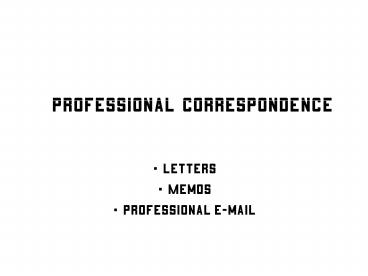Professional correspondence - PowerPoint PPT Presentation
1 / 13
Title:
Professional correspondence
Description:
Body of letter: In first paragraph, state your reason for writing; in the second ... Distribution list: List the people who received this letter. ... – PowerPoint PPT presentation
Number of Views:861
Avg rating:3.0/5.0
Title: Professional correspondence
1
Professional correspondence
- Letters
- Memos
- Professional e-mail
2
Characteristics of business letters
- Remember that letters go out of your organization
while memos are used within your organization. - Letters use conventional formatting.
- Heading your complete address but not your name
the date. Spell out words. (Street, not st.) - Inside address name and address of person to
whom you are writing. Use title and position. - Subject line Re Request for proposal Include
project numbers, if necessary. - Salutation Dear Professor Smith
3
Characteristics of business letters cont . . .
- Body of letter In first paragraph, state your
reason for writing in the second paragraph,
develop your ideas further in the third
paragraph, transition to other ideas or conclude
by requesting action. - Signature Your name and job title with a space
above for you to sign the letter. - Enclosure notations If you enclosed something,
enclosure. - Distribution list List the people who received
this letter.
4
Business letters cont. . .
- Letters are always single spaced. The only
exception is if the letter carries a lengthy
report. In that case, make it double-spaced out
of courtesy for the reader. - Use font that is 12 or 10 points.
- For letters with more than one page, use page
numbers. - If the letter is very short, center the body of
the letter on the page.
5
(No Transcript)
6
Characteristics of memos
- Memos are internal documents in your
organization. - Memos are always single-spaced.
- Memos may use preprinted forms or templates.
- Memos use specific conventions
- Do not include an address.
- Do use a subject line.
- Generally, do not sign memos. Sometimes they are
initialed. - Include special notations at the bottom.
(Enclosures, distribution, etc.)
7
Characteristics of memos
- Memos are generally short, action-oriented
documents. - If they are longer, use page numbers.
- If they are long and complex, use section
headings to help readers reader. For example, - Introduction
- Current progress
- Problems to be solved and potential approaches
- Conclusion
8
To John Smith From Mary Anderson Date September
2, 2002 Re Request for conference
funds Xxxxxxxxxxxxxxxxxxxxxxxxxxxxxxxxxxxxxxxxxxx
xxxxxxxxXxxxxxxxxxxxxxxxxxxxxxxxxxxxxxxxxxxxxxxxxx
xxxxxxxxxxXxxxxxxxxxxxxxxxxxxxxxxxxxxxxxxxxxxxxxxx
xxxxxxxxxxxxx Cc P. Burns, R, Whelan
9
Characteristics of professional e-mail
- When you use e-mail professionally, follow
business conventions, not casual chat
conventions. - Dont use abbreviations, emoticons ), slang,
cuss words, caps, bolding or italics. - Characteristics
- Has a specific, informative subject line
(always!) - Contains an interior date. (Not all e-mail
clients print date.) - Has a salutation appropriate to professional role.
10
Professional e-mail cont . . .
- Use short paragraphs to help reader read.
(Reading from the screen is 25 harder than
reading from print.) - Put white space around paragraphs.
- Use an easy-to-read font in 12 pt. (Nothing
exotic!) - Include your full name, title, and contact
information at the end.
11
Professional e-mail cont. . .
- Show your writers knowledge of e-mail
protocolscopying, forwarding, quoting, replying,
attachments, etc. - Be concise without being abrupt.
- Remember that e-mail is never private.
- Try never to argue or reprimand or complain by
e-mail. Dont send e-mail in anger!
12
Style in professional correspondence
- In correspondence, be a bit formal without being
stuffy. These documents are often shared among
others and/or are part of public record. - Get to the point. State your objectives clearly.
- Pay attention to the beginning of the
correspondence. This is where you get your
readers attention. - Pay attention to the end of your correspondence.
This is where you request specific action (s).
13
Style cont. . . .
- Other cultures have different communication
styles. Consult a knowledgeable person to make
sure that you do not offend your reader. - Always, always, always . . . . proofread your
correspondence before it is sent. Mistakes in
grammar, punctuation or spelling can make you and
your organization look careless, unskilled,
thoughtless, uninterested, uneducated, hasty,
and/or lazy. (!)































